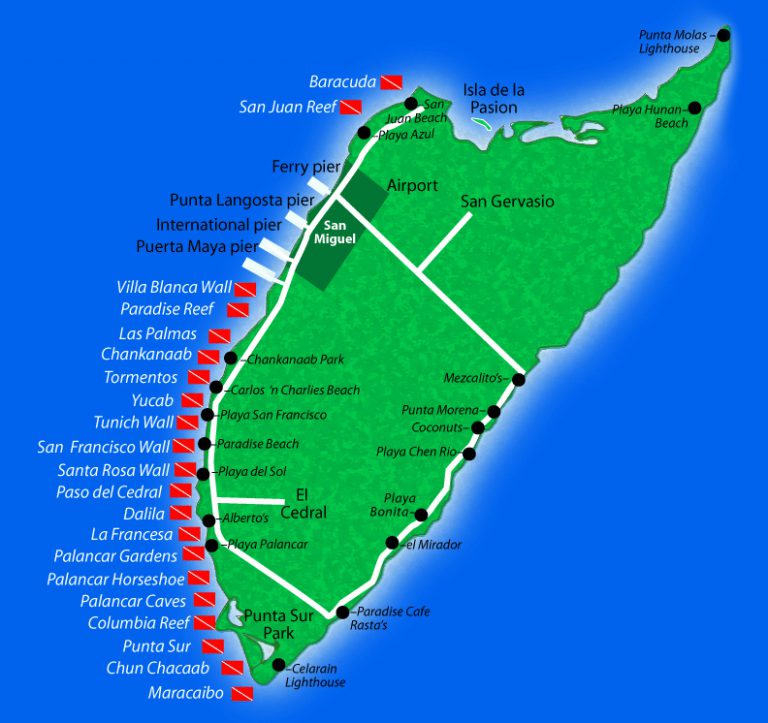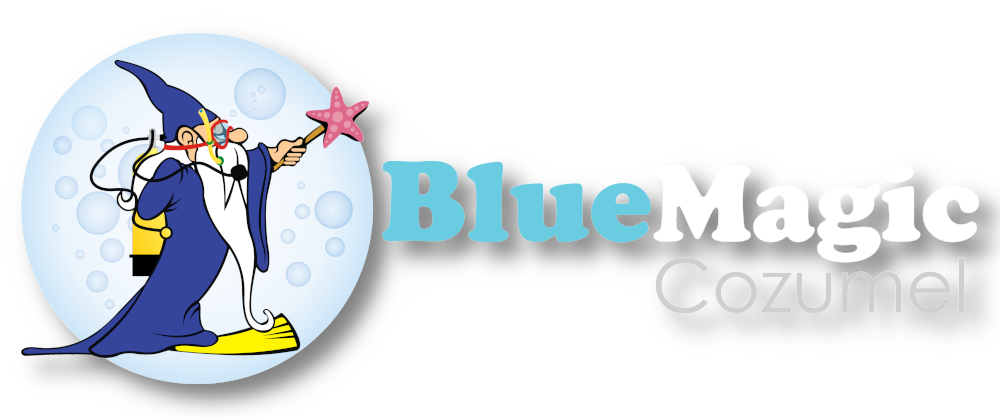The Meso-American Barrier Reef


The reefs of Cozumel are part of the second largest reef system in the world. Covering nearly 115 million acres, the almost 700-mile-long Mesoamerican Reef stretches from the northern tip of the Yucatan Peninsula in Mexico all the way to the Bay Islands in Northern Honduras.
The Mesoamerican reef is unique in the Western Hemisphere not only for its size but also because of its biodiversity. It is home to more than 65 species of hard coral and more than 500 species of fish, including the mammoth whale shark – the largest fish in the world. An ancient natural system, the reef is more than 225 million years old and functions as a natural barrier to storms and hurricanes.
Much like the rainforests, the reef systems are crucial links to all plant and animal life on earth.
Some of the places in the Marine Park that you will explore with Blue Magic Scuba are: |
1.BARRACUDA – DEPTH 45 -110 FT (EXPERT) |
| Currents are usually 3 to 10 knots and run straight out to sea. We take only small groups of experienced drift divers to this dive site. |
2. SAN JUAN – DEPTH 70 – 80 FT (EXPERT) |
| Currents are usually 3 to 10 knots and also run straight out to sea. We take only small groups of experienced drift divers to this dive site. |
3. VILLABLANCA – DEPTH 50 – 60 FT (INTERMEDIATE) |
| Different! Instead of the huge stony coral buttresses so typical of the southern deep reefs, the sloping wall here is dominated by huge sponges, gorgonians, and big schools of jacks and angelfish. It is recommended that novices make this one from a boat, but this site can be dived by more experienced divers from the beach. |
4. PARADISE – DEPTH 45 FT (NOVICE) |
| This is actually a series of three separate reefs. It is 200 yards from the shore and accessible to beach divers. All 3 sections are abundant with marine life of every size, color and description. Expect to see crab, lobster and a plethora of multicolored tropical fish. Look closely under ledges and in holes and you’re likely to spy the reclusive Splendid Toad Fish, reputed to live nowhere in the world other than Cozumel. Paradise reef is the island’s most popular night diving location. |
5. CHANKANAAB – DEPTH 55 FT (NOVICE) |
| Is just south of Parque Chankanaab and about 350 yards offshore. The coral formations and marine life are similar to but a little less populated than Paradise. Chankanaab is another good location for night diving. |
6. TORMENTOS – DEPTH 40-70 FT (INTERMEDIATE) |
| Some of the fastest currents allow you to soar over a series of colorful coral heads separated by sand valleys where you can almost always visit with a very friendly and big moray eel. A dive master’s favorite. |
7. YUCAB – DEPTH 60 FT (NOVICE) |
| Yucab’s dense low profile ribbon of corals and sponges is a cornucopia of life and color. Barracuda are almost always seen here and the current is usually swift. |
8. SANTA ROSA – DEPTH 50 -130 FT (INTERMEDIATE) |
| Undoubtedly some of the best scuba diving in Cozumel and the second most popular drop-off. The wall begins at 50 feet and drops straight away into the deep. Prepared to be mesmerized by the magic of eagle rays and turtles There is usually a brisk current and what an incredible thrill it is to literally fly the face of the wall and frolic with the playful grouper. Santa Rosa offers great beds of tunicates, immense sponges, huge overhangs of stony corals and impressive caves and tunnels best dived 60-80 ft. Awesome! |
9. PASO DEL CEDRAL – DEPTH 50-90 FT (INTERMEDIATE) |
| A fairly flat wall just brimming with life and color. Expect a swift ride that will allow you to gaze at the “aquarium” of sea life in crystal clear water as well as perhaps spotting pelagics drifting up and over the wall. |
10. PALANCAR – DEPTH 60-125 FT (NOVICE – INTERMEDIATE) |
| Palancar is actually a conglomeration of many different coral formations and personalities. Stretching over three and one half miles, this gargantuan queen reef lies about a mile off-shore and tops a sloping wall which descends to a maximum depth of over 3000 feet. Palancar offers such a wide variety of profiles that she could not be seen in 20 or even 30 dives. Just to get a glimpse and begin to feel the magic of this multifaceted giant, the diver need to make at least 6 separate dives. |
11. COLOMBIA DEEP – DEPTH 60-90-140 FT (INTERMEDIATE TO ADVANCED) |
| Columbia Deep is without a doubt one of the most spectacular deep dives here in Cozumel. The diving here is at least as spectacular as any part of Palancar. This is deep diving at its finest, with the most spectacular sights and sensations at 90 to 110 ft. Columbia is comprised of a series of gigantic coral pinnacles (many over 90 ft. tall) riddled with caves, tunnels and caverns. In some spots these pinnacles are situated far enough away from each other that you experience a unique feeling of flying or gliding over and around these large formations. Large marine life like turtles, eagle rays, barracuda and a variety of sharks are frequently seen. |
12. PUNTA SUR – DEPTH 90-120 FT (ADVANCED) |
| Incredible topography, huge caverns, many divers surface screaming with joy. Home of the Devil’s Throat which starts inside a coral swim through at 90 feet and descends down a narrow dark tunnel to an exit at 130 feet on the wall overlooking the abyss. The “Cathedral” is also located in a nearby section of the reef. Pure magic! |
13. CHUN CHA CAB – DEPTH 90-120 FT (ADVANCED) |
| Probably the most difficult to find reef in Cozumel. Diving this one takes a very special combination of captain, divemaster and weather conditions. If you do manage to get there, expect a virgin submarine fantasyland where large pelagics are often seen. |
14. MARACAIBO – DEPTH 60-120 FT (ADVANCED) |
| Often called Maracaibo or Lighthouse Reef, it is one of the southernmost dive sites on the island and is exposed to current and some surface waves due to its location. It is a deep wall dive that sometimes reveals schools of hammerheads or shoals of eagle rays. |


